October 9, 2025
Did you know that rodent calls can jump dramatically in early spring, while mosquito complaints often surge once summer heat and rain set in?
The tricky part is that these spikes don’t always arrive in the same week each year. Sometimes they come early, sometimes late, and sometimes they hit harder than anyone expects.
For pest control businesses, this unpredictability means a quiet week can suddenly turn into an avalanche of service requests, missed calls, and exhausted technicians. Teams that only react once the phone rings often find themselves playing catch-up, risking customer satisfaction and lost revenue.
How to Handle Seasonal Pest Spikes with Smart Pest Control Strategies
In this blog, we’ll explore which common pests tend to surge each season, the most effective pest control methods to use during those peaks, how to spot early warning signs like entry points and food sources, and how planning tools, including CRM triggers and seasonal calendars, can help pest control services stay ahead instead of scrambling.
Key Takeaways
- Seasonal surges don’t always follow the same schedule, making demand unpredictable.
- Weather, moisture, and food availability can shift the timing of these surges, making them unpredictable.
- Businesses that prepare with preventative and treatment strategies are better positioned to handle sudden demand.
- CRM triggers and seasonal campaigns can help pest control services manage workloads and capture more revenue during peak activity.
Understanding Seasonal Pest Control & Common Pests
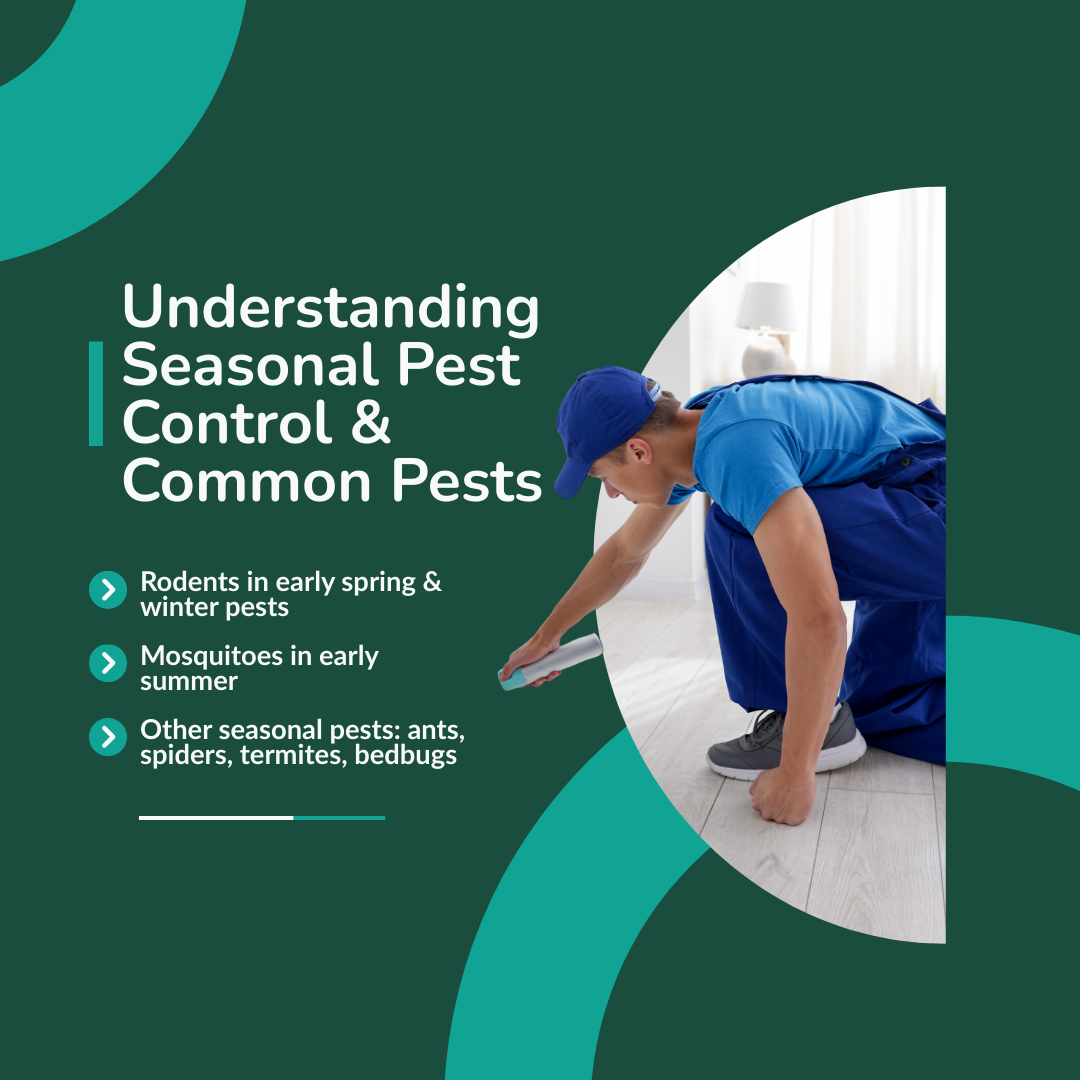
Temperature shifts, rainfall, and changes in food availability all influence when certain pests appear and how aggressive they become. While exact timing can vary, there are clear trends that pest control businesses can plan around.
1. Rodents in Early Spring & Common Winter Pests
Rodents such as mice and rats typically nest indoors during the colder months, which is why they’re often labeled as common winter pests.
As early spring arrives, they become more active, looking for food and new nesting spots. This transition period often triggers a spike in service calls, making it one of the busiest times of the year for pest control businesses.
2. Mosquitoes in Early Summer
Once temperatures rise and rain creates standing water, mosquito populations can explode almost overnight.
Early summer is the peak period, when homeowners are most likely to request mosquito treatments to protect outdoor spaces. This is because the surge can be sudden, and campaigns for prevention and treatment need to begin before conditions are ideal for breeding.
3. Other Seasonal Pests to Watch (ants, spiders, termites, bedbugs)
Ants and spiders often increase activity in early fall, when cooler weather pushes them indoors. Cockroaches and silverfish can thrive in warm, damp environments during winter.
Meanwhile, termites and bedbugs don’t follow strict seasonal cycles but can cause problems year-round, adding to the workload during already busy seasons.
Effective Pest Control Methods & Strategies for Peak Seasons
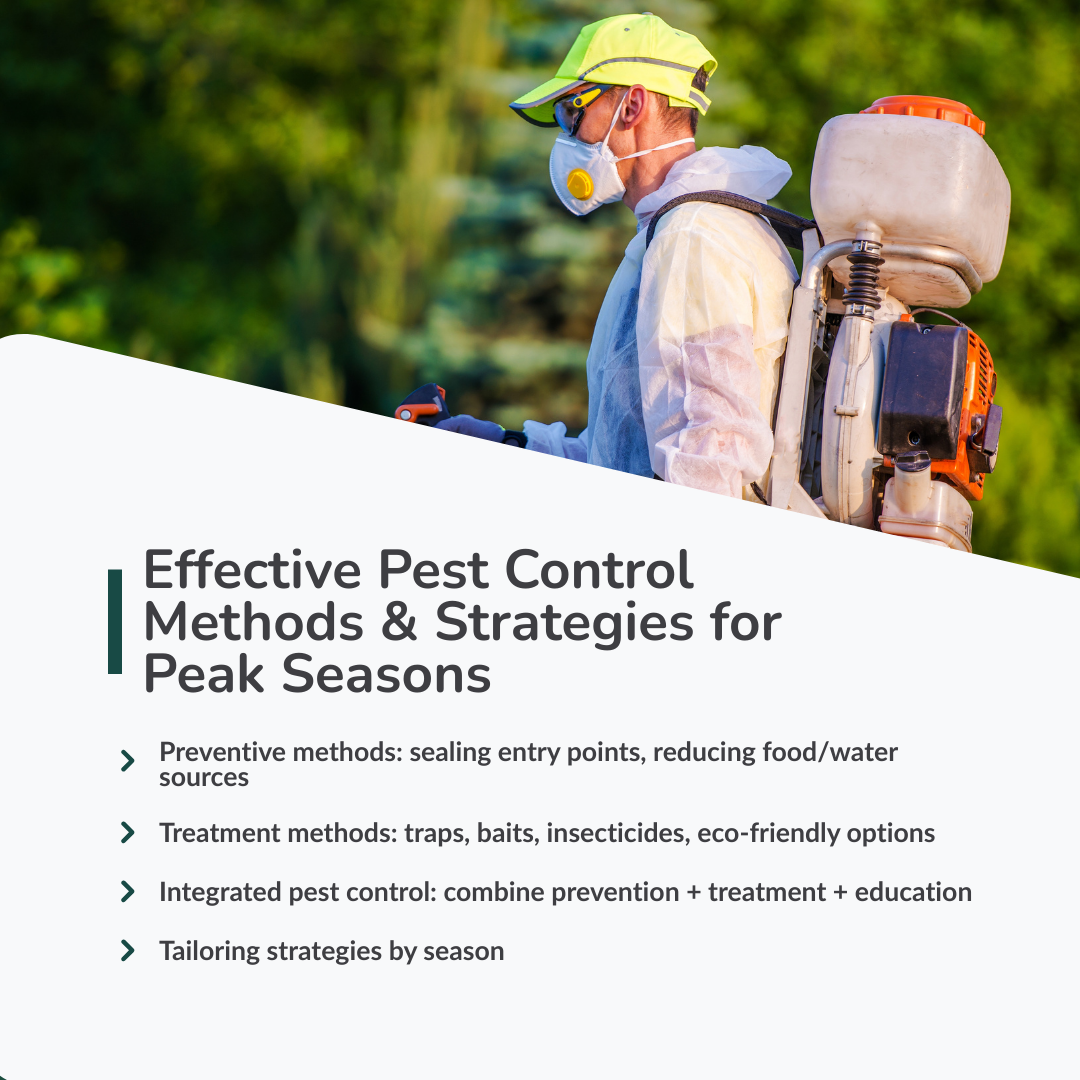
Knowing when pests are most active is only the first step to preventing pest infestation. The real advantage comes from applying the right mix of pest prevention, treatment, and follow-up at exactly the right time. Seasonal pest control is most effective when strategies are tailored to both the pest and the specific season.
1. Preventive Pest Control Methods
Prevention is always the first line of defense. Sealing entry points such as cracks in foundations, gaps around doors, and open vents makes it harder for rodents and insects to find their way inside.
Reducing food and water sources is just as critical. Keeping trash sealed, removing clutter, and draining standing water in yards all help limit pest activity before it turns into an infestation.
2. Treatment Methods During Surges
When pests do break through, treatment needs to be fast and effective. Rodent spikes often require traps, baits, or exclusion devices.
For mosquitoes, insecticides, fogging, and mosquito misting systems can provide immediate relief. Offering eco-friendly alternatives, such as natural repellents or targeted treatments, is increasingly important for customers concerned about safety and environmental impact.
3. Integrated Pest Control Strategies
The most effective pest control strategies combine both prevention and treatment.
For example, a rodent program might include sealing entry points, educating homeowners about food storage, and setting traps in high-risk areas.
Customer education plays a major role here: explaining how to reduce conditions that attract pests makes treatments more effective and builds trust in your services.
Scheduling follow-up visits ensures that small problems don’t turn into another wave of calls later in the season.
4. Tailoring Pest Control by Season
Different conditions call for different approaches, and strategies should shift as the year progresses. In spring, exclusion work and inspections can reduce rodent issues early.
During the warmer months, treatments for outdoor pests and yard maintenance take priority. As fall approaches, pest-proofing helps prevent indoor problems, while winter is the time to focus on sanitation and routine checks.
Spotting Early Pest Activity: Entry Points & Food Sources
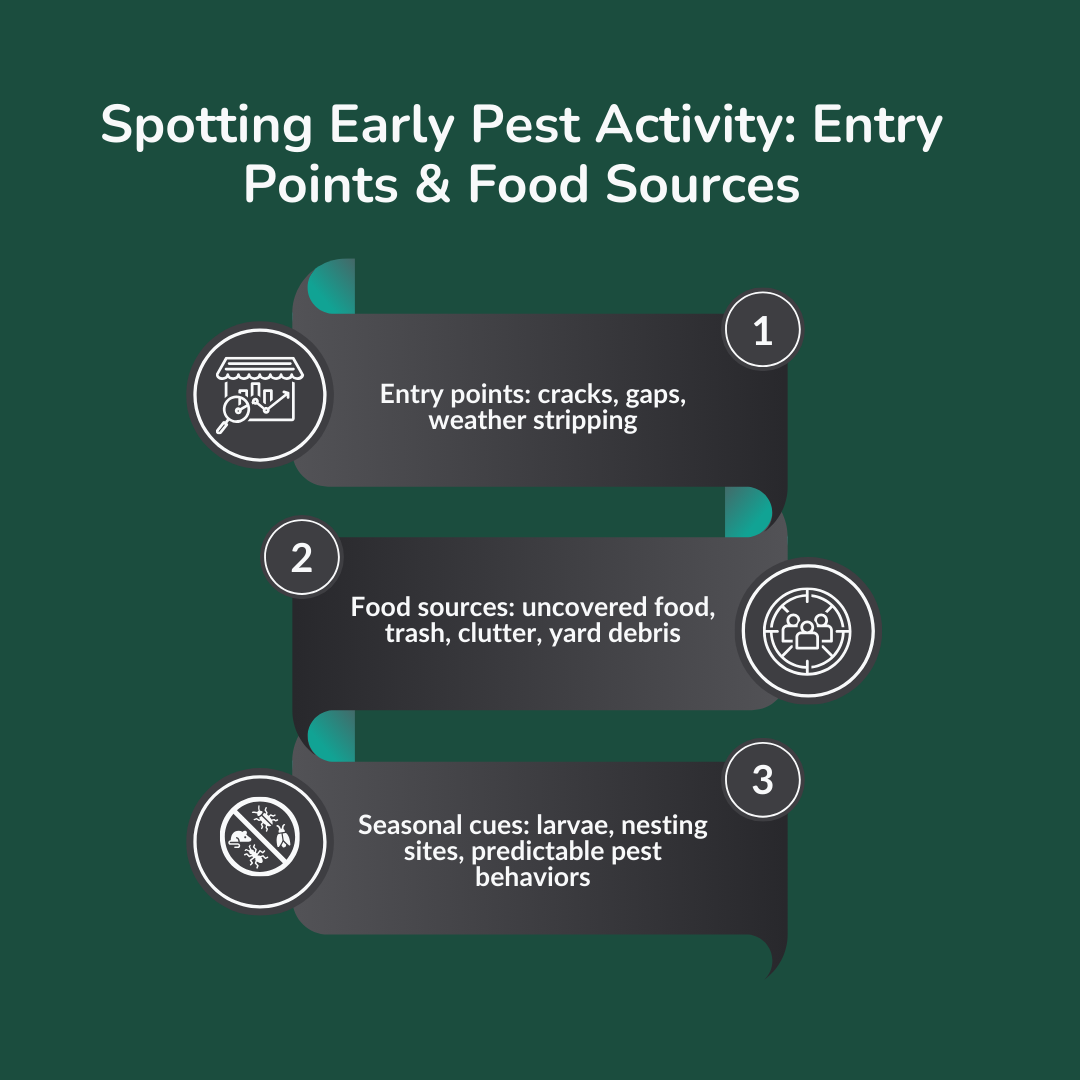
The best way to avoid a full-blown pest infestation is to catch the warning signs before they spread. Early detection not only saves time and money but also makes pest control efforts more effective and keeps homes closer to a pest-free environment.
1. Entry Points and Hiding Spots
Most seasonal pest problems start with unnoticed openings. Small cracks in foundations, gaps around doors, or damaged weather stripping can become entry points that allow pests to move indoors.
Rodents often exploit these spaces in early spring when they are seeking shelter, while other pests, such as pantry pests or carpenter ants, take advantage of gaps around outdoor areas.
Regular inspections and sealing these areas with proactive measures, such as caulking or weatherproofing, can prevent pests from becoming unwanted visitors.
2. Food Sources That Attract Pests
Food and water are the biggest drivers of pest activity. Pet food left uncovered, yard debris, or clutter in indoor and outdoor areas can attract pests and provide them with nesting sites.
Many insects also thrive in warmer temperatures when trash bins and food storage are not managed properly. Storing dry goods in airtight containers and trimming bushes around outdoor areas reduces food sources that pests rely on.
3. Seasonal Cues and Preventive Measures
Certain pests reveal themselves at predictable times, even if the exact timing shifts year to year. Regularly check these risk areas, apply preventive measures, and use thorough inspection routines to prevent future infestations.
Spotting seasonal behaviors early, whether it’s rodent activity, mosquito larvae, or pantry pests, is the foundation of proactive pest management.
Planning for Sudden Pest Control Demand Surges
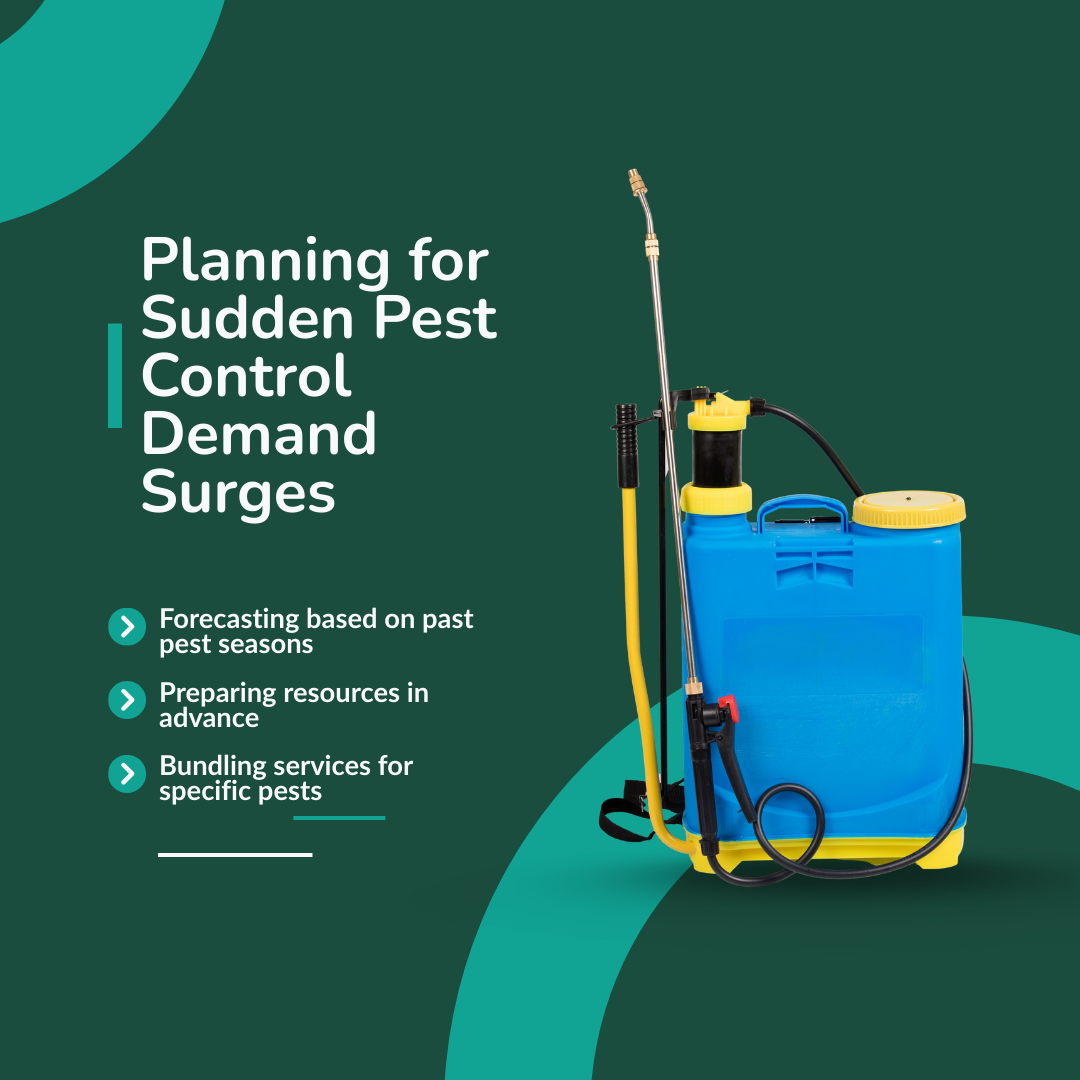
Even with proactive pest management and preventive measures, there will be times when pest control services face sudden spikes in demand, as pest activity doesn’t always follow a predictable pattern. Without a plan, these unpredictable pest problems can overwhelm even experienced teams.
1. Forecasting Based on Past Pest Seasons
Looking back at previous pest seasons provides valuable insight into when different pests are most likely to appear.
Tracking rodent activity in early spring, mosquito surges in early summer, and winter pest problems like bed bugs during colder months helps identify trends. This data-driven approach turns random pest invasions into more manageable cycles.
2. Preparing Resources in Advance
When pest behavior indicates a surge is approaching, preparation is crucial. Stocking bait stations, traps, and supplies early prevents shortages when many pests suddenly appear.
Training technicians to spot seasonal behaviors, such as nesting sites, hiding spots, or seasonal migration patterns of certain pests, ensures they’re ready to deliver targeted treatments.
Scheduling regular inspections with customers before pest activity peaks also helps prevent future infestations.
3. Bundling Services for Specific Pests
Seasonal pest packages are an effective way to prepare both your team and your customers. Offering “Spring Rodent Prevention,” “Summer Mosquito Control,” or “Fall Pest-Proofing” bundles creates clear, timely solutions.
These packages combine pest control methods, such as sealing entry points, trimming bushes, and removing yard debris, with educational information that helps prevent pests from becoming unwanted guests in both indoor and outdoor areas.
Using CRM Triggers for Seasonal Pest Control Campaigns
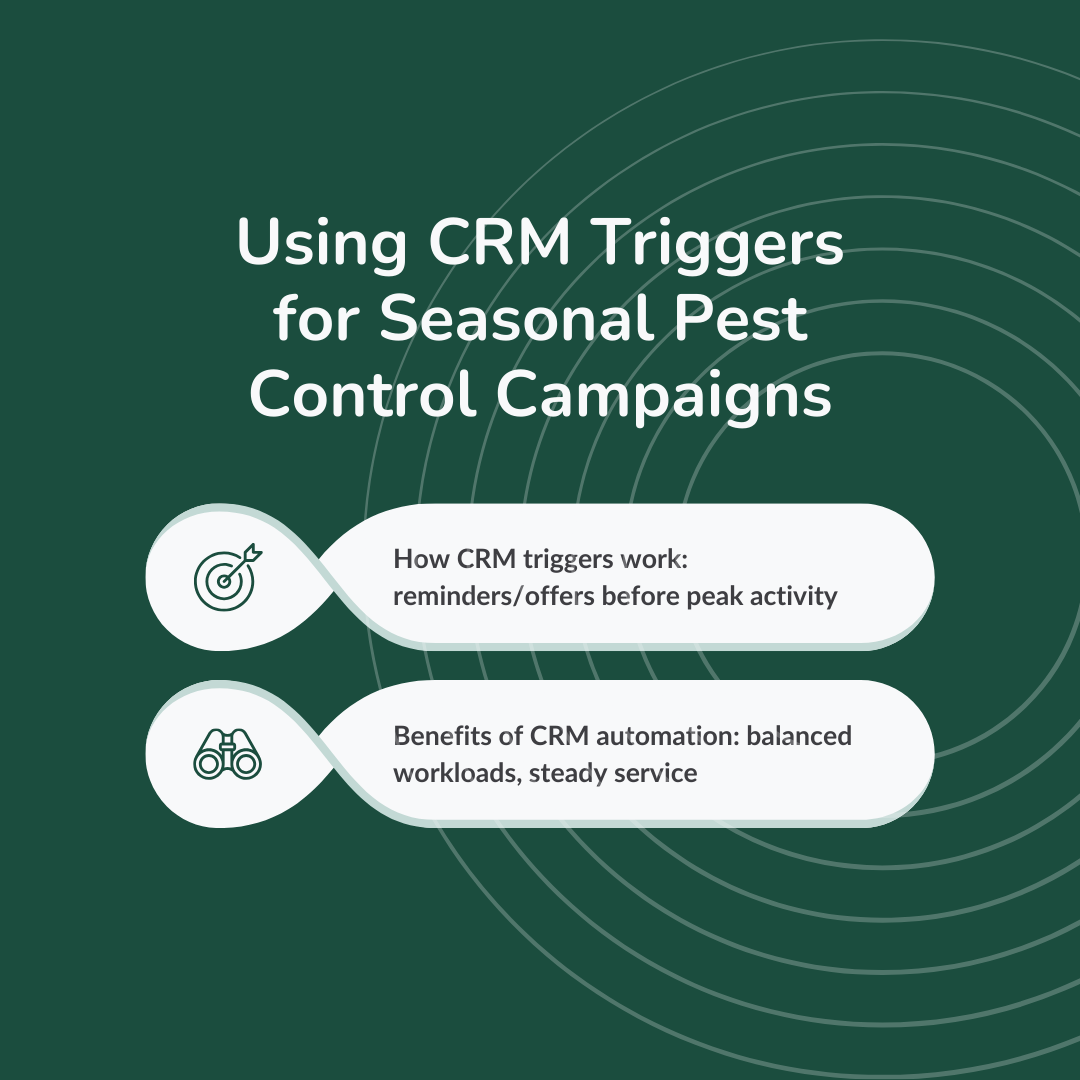
When pest control services rely only on phone calls to book jobs, they’re forced into constant reaction mode. Seasonal pest activity doesn’t wait, and customers who feel ignored may turn to competitors.
This is where CRM triggers become a powerful part of pest control strategies, helping you send the right message at the right time.
How CRM Triggers Work
A CRM tracks customer data, service history, and scheduling patterns. With automated triggers, you can send reminders or offers just before activity typically increases, whether that’s at the start of spring, ahead of summer, or in the weeks leading into winter.
Seasonal Campaign Examples
- Spring: Inspection reminders to catch early issues.
- Summer: Promotions for outdoor treatments before peak demand.
- Fall: Pest-proofing offers as cooler air sets in.
- Winter: Indoor check-ups and sanitation reminders.
Benefits of CRM Automation
Automated campaigns keep workloads balanced and reduce overworking during busy weeks. By segmenting customers and scheduling outreach in advance, pest control businesses can stay prepared while delivering steady, reliable service.
Building a Seasonal Pest Control Calendar
Seasonal mapping isn’t about memorizing which pests show up when, as you already know that from experience. The value comes from organizing those patterns into a clear framework so you can anticipate demand, prepare resources, and keep your team ahead of the curve.
By breaking the year into four phases, pest control businesses can plan staffing, stock, and marketing long before customers start calling.
Aligning CRM Campaigns with Pest Cycles
Once the year is mapped, the next step is tying it to your CRM. Instead of getting worked up when demand surges, campaigns can be automated to launch just before peak activity.
That might mean sending rodent inspection reminders in spring, mosquito control offers in summer, or pest-proofing promotions in fall. This alignment keeps schedules full and customers reassured without constant manual effort.
Sample Seasonal Calendar
| Season | Months | Focus Pests & Services | Example CRM Campaign |
|---|---|---|---|
| Spring | March – May (Northern Hemisphere) September – November (Southern Hemisphere) | Rodent inspections, exclusion work | “Book your spring rodent inspection before activity peaks.” |
| Summer | June – August (Northern) December – February (Southern) | Mosquito control, yard treatments | “Protect your home from mosquitoes this summer. Schedule treatments now.” |
| Fall | September – November (Northern Hemisphere) March – May (Southern) | Pest-proofing for overwintering insects and rodents | “Seal your home before pests move in for the winter.” |
| Winter | December – February (Northern Hemisphere) June – August (Southern Hemisphere) | Indoor inspections, sanitation, and monitoring | “Stay pest-free this winter with a full home check-up.” |
A calendar like this shifts pest control from a reactive to a proactive approach. Instead of chasing problems after they appear, you create a rhythm of steady, predictable work throughout the year.
How PestBase Helps Pest Control Businesses Stay Ahead
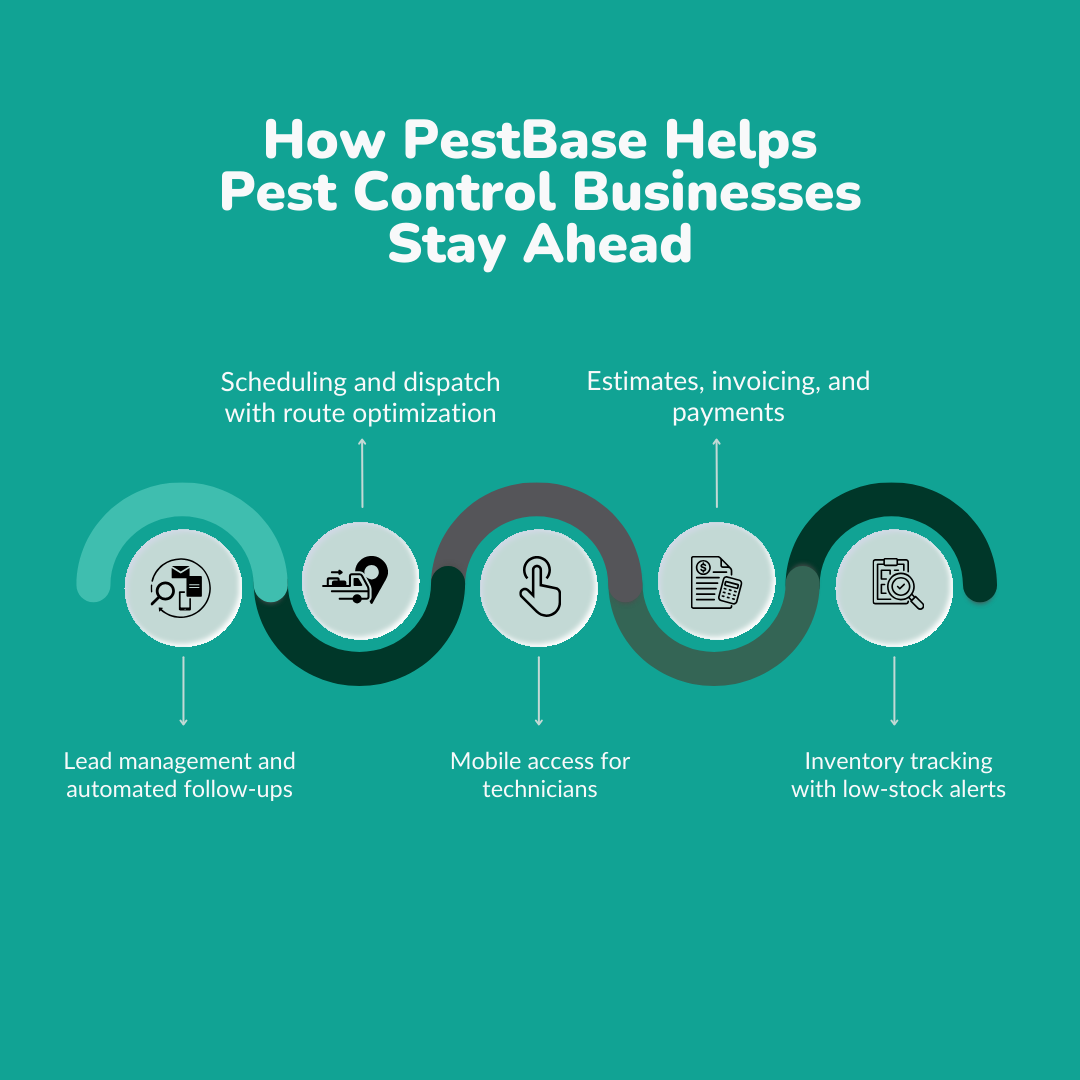
Seasonal demand can put pressure on every aspect of a pest control business, from capturing leads to scheduling jobs and managing supplies. PestBase brings these tasks into one system, making it easier to stay organized when activity spikes.
- Lead Management and Follow-Ups: All new inquiries flow directly into a built-in CRM. From there, you can set up reminders, follow-ups, or seasonal campaigns so customers hear from you before they start calling competitors.
- Scheduling and Dispatch: With a visual calendar and route optimization, assigning the right technician to the right job is straightforward. This helps maintain balanced schedules and reduces wasted time on the road.
- Mobile Access for Technicians: Technicians can see job details, upload photos, and mark work as complete from their phones. That means fewer delays in communication and less paperwork during busy periods.
- Estimates, Invoicing, and Payments: Proposals, contracts, and invoices are created and shared digitally. Payments can be collected on-site or online, which shortens the time between finishing a job and getting paid.
- Inventory Tracking: Materials and supplies are tracked in real time. Low-stock alerts help you restock before peak season demand leaves you short.
- HR & Admin Tools: Manage employee records, shift scheduling, onboarding checklists, payroll-ready logs, and compliance tracking, all within a unified system.
- Proposals & Estimates: Generate branded proposals and accurate estimates quickly. Auto-fill customer info, pricing, and services, then send for e-signature approval.
- Automation & Workflows: The system can automatically assign jobs based on crew availability and location, while sending real-time updates to field teams.
Conclusion: Stay Ahead of Pest Activity with Planning & CRM
Seasonal demand will always be part of the pest control business, but it doesn’t have to be overwhelming.
By understanding the cycles, applying smart prevention and treatment strategies, spotting early warning signs, and planning resources in advance, you can turn unpredictable spikes into steady, manageable work.
Tools like CRM triggers and seasonal calendars make it easier to stay prepared, while platforms like PestBase bring all the moving parts together, from lead capture to scheduling and inventory.
Next Steps for Your Pest Control Business
Want to make your busy season easier to manage? Explore how PestBase can help you capture more leads, schedule jobs efficiently, and automate seasonal campaigns. Book your demo today!
FAQs
1. What is seasonal pest control?
Seasonal pest control is the practice of aligning your services and campaigns with the natural cycles of pest activity. Instead of waiting for infestations, you anticipate when demand will rise and prepare your team and customers in advance.
2. Why do pest spikes feel unpredictable?
While pests tend to follow seasonal patterns, weather shifts, rainfall, and food availability can change the timing and intensity. That’s why one spring may be quieter and the next may bring sudden surges.
3. How can CRM triggers help during peak pest seasons?
CRM triggers automate reminders and promotions based on timing. For example, sending inspection reminders before spring or pest-proofing offers in fall ensures customers hear from you before problems escalate, keeping your schedule balanced.
